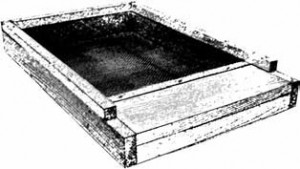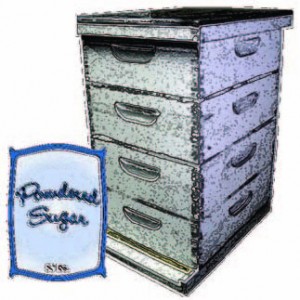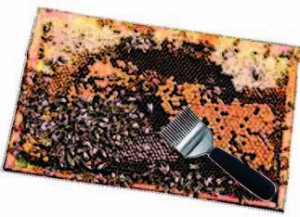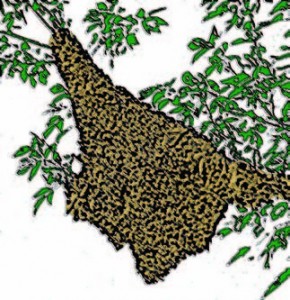Managing Varoa: Part 1 – IPM Realities
I welcome practical, tested tips, methods, and assessments from other beekeepers who are successfully keeping bees with varroa. I found this article to be a good reality check on certain varroa IPM methods. It was originally published in the March 2011 ABJ, and I asked the author if I could post it to this website. I’ve come to largely the same conclusions as Roy about screened bottoms, sugar dusting, home brew essential oils, and drone trapping, with some caveats:
- After running some 500 screened bottoms for several years, I am phasing them out of my commercial operation, as for me their downsides outweigh their benefits. However, if you depend upon sticky boards for mite monitoring, or sugar dusting, then you may find them of use.
- I see far too many failures with beekeepers who depend upon sugar dusting as the sole mite management method. In order for sugar dusting to be effective, it must be started when mite levels are very low, and then diligently continued as long as the bees are rearing brood. It cannot be depended upon to actually reduce mite levels so long as brood is present.
- Some beekeepers appear to have success with certain homebrew formulations of essential oils, but not I. I can personally vouch for the efficacy of Apiguard thymol gel if applied at 25 g (1/2 dose) into the center of the broodnest. This is currently my favorite warm-weather mite treatment.
- There are also other effective “natural” treatments on the market–see my article “Miticides 2011.”
- I still do mite trapping with drone frames, as per my article “IPM 5.5.” I find it to be a quick and cost-effective way to knock back mites in early spring. I also like that use of the trap frames minimizes the bees’ reworking of worker foundation into drone cells.
- I agree with Roy’s assessment that selection for mite-resistant stock is the long-term solution. However, few beekeepers will find that picking up swarms is an effective way to restock their operations. Splitting of your hives once or twice yearly (as promoted by Kirk Webster and Michael Palmer) may be more practical.
by Roy Hendrickson, Chardon, Ohio
Several months ago I eavesdropped on a conversation between several experienced beekeepers at one of the local meetings I occasionally attend. The gist of the conversation concerned the success rate for new beekeepers. The participants generally agreed that only about 25 percent of new beekeepers would still be active two or three years hence. If correct, that equates to roughly a 75 percent failure rate among entry level operators. What type of business or industry would be satisfied with a 75 percent failure rate? At the personal level, would you be satisfied if your financial advisor was wrong 75 percent of the time? What about your family doctor, or your auto repair shop? Why then would any beekeeper, beekeeping organization, or the industry as a whole be content with such a dismal success rate? I am truly at a loss to explain this phenomenon.
As always, today’s new beekeeper faces the burden of learning the basics of bee biology and colony management, no easy prospect absent a mentor or nearby instructional opportunity. Add to that an understanding of Varroa biology and the ever changing complexities of Varroa control and it’s no wonder both new and established beekeepers are struggling to survive. However, I believe there is another insidious aspect at work here, the power of repetition. Simply stated, if something is repeated often enough over a long enough period of time, it eventually becomes accepted fact, irregardless of its degree of accuracy. To put it another way, be careful to whom and what you listen to when it comes to the topic of Varroa control. Beekeepers are continually being inundated with incomplete, poor, or downright inaccurate information on the subject. I often wonder how many information providers, i.e. bloggers, magazine authors, public speakers, and equipment dealers have actually succeeded in doing that which they routinely recommend to others. In my opinion, anyone who sits down at a keyboard, picks up a microphone, or sells equipment has a responsibility to set the record straight. In other words, tell the Varroa story as it is, not how you would like it to be.
The sole object of this article is to take an honest, realistic, and unbiased look at some of the common inaccuracies, distortions, and plain bad advice that permeate the Varroa information stream. Increasing the small beekeeper success rate through the dissemination of honest and accurate information is my only goal. Future articles will explore the means and methods by which small operators can establish a chemical-free mite control program.

Screened Bottom Boards
Varroa was first discovered in Wisconsin in September 1987. Within a couple of months it was found in at least seven or eight additional states, primarily states that were frequented by the eastern migratory pollinators of that era. I’m not exactly sure when or where the first screened bottom board appeared, but they had become commonplace by the mid to late nineties. Since that time, through the power of repetition and ceaseless promotion screened bottoms have become pervasive throughout the hobbyist and sideliner ranks. Today virtually every new beekeeper is sold an overpriced, often poorly constructed screened bottom board, under the premise that it will not only aid in controlling Varroa, but provide an abundance of much needed ventilation as well.
In reality, after 10 or 12 years of continued use it should be obvious to all concerned that screened bottom boards have very little to offer in the way of Varroa control. If they did, the aforementioned hobbyist and sideline operators would be largely free of this scourge, and that is simply not the case. To the contrary, Varroa control is still the most important colony management issue they face. If you’re still not convinced, a threeyear study of screened bottom boards (2001- 2003) done at Cornell University ended with the conclusion that “screened bottom boards are not recommended for control of V. destructor in the northeast.”1
In addition to being ineffective for Varroa control, screened bottom boards are also detrimental to spring colony management. For those operating in areas with a well defined winter season, followed by a cold erratic spring weather pattern, screened bottoms have the potential to cause considerable harm. I base the majority of my case on the following human analogy. Imagine for a moment that it’s mid March and you’re in Northeastern Ohio. Nighttime temperatures usually average between 25 and 35 degrees. Daytime averages range between 40 and 50 degrees. Under those conditions, would you as a homeowner open all the doors and windows in your house and leave your thermostat at its normal setting until the weather warmed to the point where the furnace was no longer required? Seriously, how many of you would opt for this course of action? Then, why would you ask your bees to do the same thing?
If your spring management agenda involves the use of open-screened bottom boards, you are creating an exact duplication of that analogy. Under this operating scenario, the open bottom will not only limit colony expansion, but you run the risk of damaging the established broodnest as well. For example, in order to initiate brood rearing a colony has to warm the center of the broodnest up to 93-94 degrees. As the season progresses and the broodnest starts to expand downward, the colony’s need to generate internal warmth conflicts with the cold air entering through the open bottom board. The result is a reduction or cessation of broodnest expansion. Abnormally cold temperatures often result in chilled brood and broodnest regression, the absolute worst case scenario. The same general circumstance occurs with solid bottom boards when the normal winter entrance reducer has been removed early in the spring in the interest of increasing colony ventilation. Reversing the brood boxes where screened bottoms or open entrances are in play is a recipe for real disaster; broodnest obliteration is the likely end result! One final observation, even with the slide in place, most screened bottoms are still rather drafty affairs. Use several thicknesses of cardboard and a little duct tape to shim up the slide and seal the cracks. The benefits will far outweigh the time and effort invested.
The primary object of any spring management program should be the production of strong colonies preparatory to their intended end use. The use of screened bottom boards and open entrances runs counter to that end. Err on the side of caution until the spring temperatures have stabilized and your colonies are at or near full strength. From that point on, an open entrance or screened bottom is of little consequence.
 Powdered Sugar Dusting
Powdered Sugar Dusting
The practice of routinely dumping powdered sugar into beehives has become the rallying call of the Varroa impaired. Coat your bees with powdered sugar and Madam Mite will lose her grip and fall to her demise through the open screened bottom board, or so the theory goes.
In actual practice dusting with powdered sugar does only one thing. It removes somewhere between thirty and forty percent of the Phoretic mites from their temporary adult bee hosts. That’s it! During the active brood rearing months, approximately sixty percent of a colony’s mite load is in the capped brood, dusting has absolutely no affect on this segment of the population. The Phoretic mites that are removed through the dusting process are replaced as the colony’s mature brood emerges, hence the need to dust on a regular basis. It’s a vicious cycle, with literally no end in sight! A 2009 study out of Florida found that dusting colonies with 250 ml (1 cup) of powdered sugar at two-week intervals, over the course of ten months “did not significantly reduce the total number of mites per colony, the number of mites per adult bee, or the number of mites per capped brood cell.” Furthermore, even though the test colonies were dusted throughout the relatively broodless winter period, there were still no “significant differences in mite populations between dusted and undusted colonies.” In addition, the study appears to confirm earlier work by others “that at lower mite densities, the reproductive rate of Varroa increases. Therefore, the mite may be able to compensate for population loss due to dusting by increasing its reproductive rate.”2
Powdered sugar dusting is at best a labor intensive short-term means of Varroa control. I refer to the dusting procedure as the here and now, or pay as you go method. Its only long-term benefit is a false sense of security, which will be replaced by disaster once you stop dusting. Like its predecessor, the screened bottom board, this method of controlling Varroa is an idea whose time has passed. Serious beekeepers need to advance their agenda and strive for realistic longterm solutions to the Varroa dilemma.
 Essential Oils
Essential Oils
The use of home remedy essential oils as a means of Varroa control was quite the rage a few years back, but it seems to have fallen out of favor of late. At least the popular bee press has been rather quiet on the subject. Over the years a variety of essentials oils have been studied, both to determine their efficacy as a means of controlling Varroa, and the feasibility of developing a marketable product should the research merit that effort. To the best of my knowledge, no such Varroa control products have reached the U.S. market except the thymol products Apiguard and Apilife Var.
From an operational standpoint I know several beekeepers who have, or are currently attempting to use essential oils as a means of Varroa control, with very limited success. Beyond that my knowledge of these products is somewhat limited. I believe their primary mode of action is similar to that of powdered sugar dusting; in effect they reduced the number of Phoretic mites on the adult bee population. If correct, that necessitates a routine treatment regimen, again similar to that required of powdered sugar dusting. Sounds like the same old tired routine, but this method of control involves some additional problems.
At high concentrations some types of essential oils are extremely toxic. From that perspective the safety and contamination issues become the real areas of concern. For example, what are the inherent dangers involved in simply handling these products? At what concentrations do essential oil mixtures become toxic to the colony or worse yet, to the applicator? Unfortunately, I’m not aware of any easily accessible information resource on these subjects.
Product contamination is the other major area of concern. Two more critical questions come to mind. How much exposure to an essential oil control agent is required to contaminate the marketable hive products? And, what application methodology, i.e. spraying, misting, or trickling pose the greatest threat of product contamination? Those are not the type of questions most beekeepers want to hear, much less address. Again, specific information on those subjects is almost nonexistent. If you think these questions aren’t serious or they lack substance, here’s a little food for thought on the subject. If you own an insurance policy that specifically covers your beekeeping operation, ask your agent where your greatest insurance risk lies. You might be surprised to learn that stinging, accidental or otherwise is not at the top of the list. The same holds true with the myriad of other mishaps that might befall your average beekeeper. Number one on the list of beekeeping insurance risks is product liability, some type of contamination issue involving one of the hive products you routinely sell or give away! Beware of essential oils!
 Drone Trapping
Drone Trapping
Drone trapping is the one IPM control strategy that offers the small operator a legitimate opportunity to achieve some degree of Varroa control. Unfortunately, it’s probably the most labor intensive of the common IPM strategies, and it lacks season long consistency.
In practice drone trapping works best early in the season when colonies are normally rearing large numbers of drones preparatory to swarming. As the season progresses, there is a gradual decline in the amount of worker brood being produced. This trend is accelerated for drone brood. Drone production is also dependent on a continuous supply of incoming pollen, without that drone production will shift into reverse in short order. For that reason alone, the emphasis on drone trapping should come early in the season, unless of course, you plan to feed a pollen substitute.
Drone trapping gets progressively more complicated once the supers go on. Routine trapping will necessitate the timely removal and replacement of those supers. Manageable perhaps, if you’re working with a few of colonies in the back yard, but totally unrealistic for anything much beyond 20 or 30 colonies. Even at that level you had better have a strong back and the physical capacity to bench press a dump truck if you expect to survive. I know because I’ve tried it, thank you!
Once your drone frames are full and capped don’t automatically freeze or cut the brood out. Instead, use a cappings scratcher to remove and count the number of mites in several different areas on the comb. Early in the year it’s not uncommon to find only a few mites, occasionally you won’t find any. Possibly the rearing colony simply has a low mite count coming out of winter, or perhaps there’s a resistance factor involved. Either way, return the frame to the colony and allow that round of drones to emerge. Drones from low mite count colonies are a good thing. Use them at every opportunity. If you are really serious about controlling Varroa without the use of chemicals, genetic selection is the only route available. You have to start that selection process somewhere. Preserving or propagating drones from low mite count colonies is as good a place as any.
 Swarming
Swarming
Swarming is without question the most effective form of IPM Varroa control. Untold numbers of beekeepers unwittingly practice this type of mite control, and I suspect that a good number mistakenly credit one or more of the traditional IPM strategies for their success. I firmly believe this mistaken identity is one of the main reasons that screened bottom boards and the powdered sugar dusting regimen have remained pertinent.
I also believe swarming is the major player in the resurgence of the feral colony population, at least at the local level. For example, I have an acquaintance who hasn’t used any form of mite treatment, IPM procedures included, for over ten years. His colony resilience comes from their propensity to swarm, routinely! Winter losses are replaced through swarming, the same with apiary expansion. In worst case scenarios he relies on the true feral population to supply his needs. As you have no doubt guessed, my friend is basically running a feral operation in Langstroth equipment. He takes what Mother Nature has to offer, and doesn’t concern himself one whit with Madam Varroa. I might add he’s quite happy with his success.
The swarming principles described above, when coupled with a realistic management and stock selection program, should in time allow virtually any beekeeper to practice the art of chemical-free beekeeping.
References
1. Calderone, N.W. A three-year study of screened bottom boards in the Northeast. Proceedings of the American Bee Research Conference (2007) American Bee Journal 147 (5): 436 – 437
2. Amanda M. Ellis, Gerry W. Hayes, and James D. Ellis. The efficacy of dusting honey bee colonies with powdered sugar to reduce Varroa mite populations. Journal of Apicultural Research and Bee World (48) 1: 72 – 76 (20)



